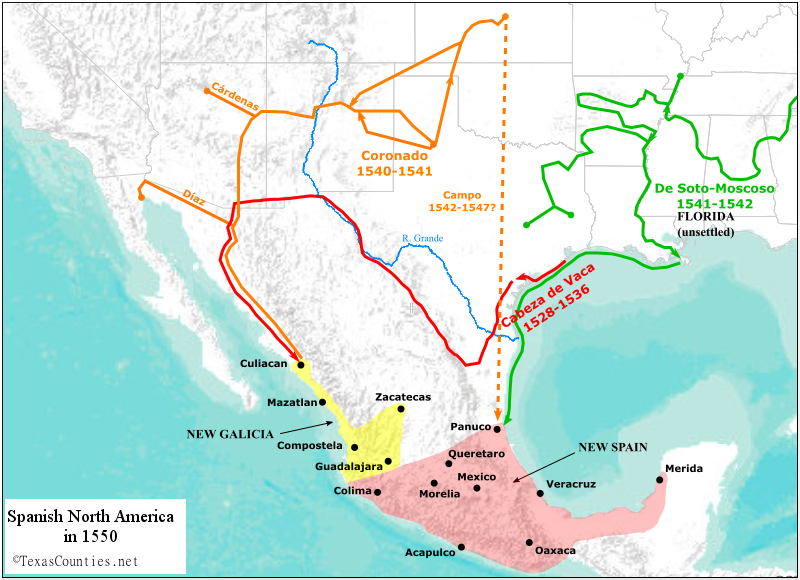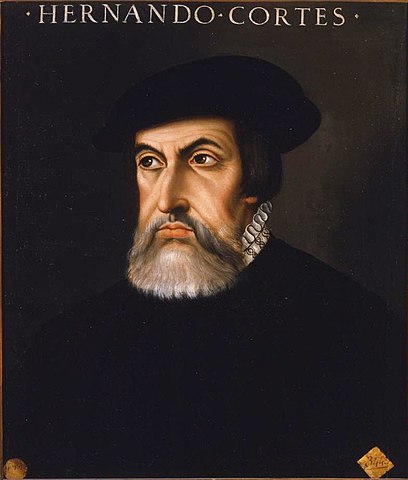
The Discovery and Initial Exploration of North America, Part 3
The Discovery and Initial Exploration of North America, Part 3
- Cabeza de Vaca's Journey, 1528-1536
- The Myth of the Seven Cities of Gold
- The Coronado Expedition, 1540-1542
- The De Soto Expedition, 1541-1542
- Diminishing Interest in North America, 1542-1550
- Conclusion
Next: TBD
Cabeza de Vaca's Journey, 1528-1536
As related in the previous part of this article, Spain's biggest concern for North America in the 1520s was deciding who had the right to explore, conquer, and govern the part of the mainland now known as Mexico - specifically, whether it should be Hernán Cortés or someone else. Spain's secondary priorities included exploring Florida and attempting to find a passage from the Atlantic Ocean to the Pacific Ocean. The territory north of Mexico and west of Florida, including Texas, was not a priority at all. This suddenly changed in 1536, when four survivors of the long-lost Narváez Expedition to Florida walked into a Spanish slaving camp in the present-day Mexican state of Sinaloa, which was then part of the province of New Galicia. These men - Spaniards Álvar Núñez Cabeza de Vaca, Andrés Dorantes, Alonso del Castillo, and Dorantes's Moor slave, Estévan - are collectively known as the "Four Ragged Castaways." They told the story of how they and about 200 other members of the Narváez Expedition ended up getting stranded on the coast of present-day Texas and how their numbers dwindled down to four. They spent much of their eight years in Texas as slaves of primitive, often savage native tribes. After they escaped, they were accepted by friendly natives who believed them to be "children of the sun," with the power to cure illness. These natives accompanied them in ever-increasing numbers and guided them across the continent in a grand entourage.
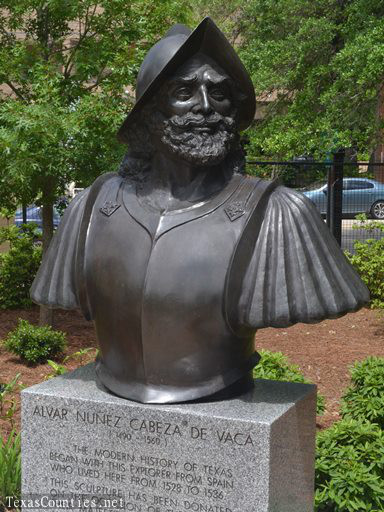
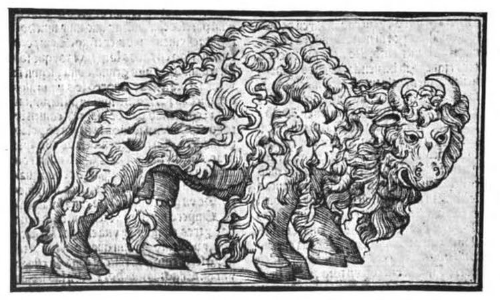
For a detailed examination of the Narváez Expedition and a thorough interpretation of Cabeza de Vaca's route through Texas, please see our group of articles under the heading, "The Discovery of Texas." A brief summary is as follows: Pánfilo de Narváez, the old foe of Cortés who was awarded the governorship of Florida, sailed from Cuba with five ships and 480 men. His pilot got lost and could not find Tampa Bay. Narváez disembarked at an inferior port on April 10, 1528, then sent his ships away to go find a better one while he took the bulk of his forces on an overland march to try to find gold. The men and the ships never located each other. Narváez and his men, racked by illness in hostile native territory, built five boats to leave Florida. They sailed westward along the Gulf coast - together, at first, but then they became separated.
On November 5, 1528, a boat carrying Andrés Dorantes, Alonso del Castillo, and about 38 other men - one of whom, presumably, was Estévan - landed on the west side of San Luis Pass in present-day Brazoria County. The following day, Cabeza de Vaca's boat landed about 5 to 7 miles west, on Follet's Island. Another boat landed near the mouth of the San Bernard River. Narváez's boat landed a few days later on the Matagorda Peninsula, and the fifth and last boat landed somewhere further south, possibly North Padre Island. Most of the boats were damaged and unusable. One night in mid-November, while everyone was asleep, Narváez and two other men drifted out into the Gulf on the last good boat without food, water, or oars and were never seen again.
Most of the 200 or so surviving castaways ended up in one of two large groups - one on Follet's Island near Galveston Bay, and the other on the west side of Matagorda Bay in Calhoun County. Only 18 castaways made it through the winter, most dying of starvation and illness. Between the spring of 1529 and the spring of 1533, the 18 castaways were reduced to four. Five died of starvation or illness, four were killed by natives, two drowned, and three lost contact with the others. Cabeza de Vaca, Dorantes, Castillo, and Estévan became slaves of two different tribes who lived in the vicinity of the lower Guadalupe River, probably in present-day Calhoun and Refugio Counties.
The natives keeping the four survivors migrated annually to south Texas to eat prickly pear fruit, or "tunas." During one of these migrations, in September 1534, the four castaways escaped. They lived as guests of friendlier natives for another 8 months in the Rio Grande valley area. Around May of 1535, they began walking south, with the intention of going to Panuco. After they crossed the Rio Grande and saw the Sierra Madre Oriental mountains, they noticed that following the base of the mountains would force them toward the coast. They wished to avoid this because their experiences up to that point made them believe that all coast-dwelling natives were vicious. They changed directions and went on a new route that ended up taking them along the Texas side of the Rio Grande from Presidio to El Paso in about November. Leaving Texas again, they crossed the Rio Grande for the last time and spent another five months walking to San Miguel de Culiacan in New Galicia.
As the four ragged castaways made their way to Mexico, their fame and their amazing story of survival and endurance preceded them, and they entered the capital with celebrity status. The Spaniards then had audiences with Viceroy Mendoza, Marquis Cortés, and Juan de Zumarraga, the bishop of Mexico. In their reports, they depicted Florida and the coastal region of Texas as utterly lacking in valuable resources and populated by nomadic, aggressive natives who were constantly battling starvation and who had no interest in the Gospel. In contrast, they depicted northern Mexico - roughly the present-day states of Tamaulipas, Nuevo Leon, Coahuila, Chihuahua, and Sonora - as populated by friendly natives, many of whom lived in fixed villages and houses, and who seemed receptive to the Gospel. Moreover, there were mineral deposits, including iron, in the mountains, and somewhere on a road to the north that the castaways did not take, copper was abundant, and there was a community of natives who smelted it and cast it into molds.
After the three Spaniards made their report, Cabeza de Vaca went back to Spain. He had been Narváez's second-in-command, and he wanted to be appointed as the new governor of Florida. After this request was denied, he wrote an autobiographical account of the Narváez Expedition. His account, called La Relación ("The Account"), is the oldest written record of Texas history. Cabeza de Vaca and his colleagues, who were the first non-indigenous people known to set foot on Texas soil, visited some 20 or more present-day Texas counties and crossed many rivers, including the Brazos, the Guadalupe, the Nueces, and the Rio Grande. Cabeza de Vaca gives the first description animals such as the American bison and the opossum, and he documents the appearance and culture of many of Texas's native tribes. La Relación is a work of immense historical and anthropological value. Our own translation of La Relación is available on this web site.
The Myth of the Seven Cities of Gold
While Spanish citizens and officials were glad to hear about the four ragged castaways' safe return and about the previously-unexplored wilderness to the north being a good prospect for settlement, it was their news about a village of metalworkers that caused the most excitement. In 1517, Francisco Hernández de Córdoba found gold on the Yucatan Peninsula; that discovery led to the conquest of New Spain, a kingdom of riches beyond anyone's imagination. In 1528, another rich kingdom, Peru, was discovered. Francisco Pizarro's conquest of it in 1532 proved that New Spain was not unique. If there were two kingdoms of vast wealth in the Americas, why wouldn't there be a third?
Naturally, Viceroy Antonio de Mendoza wanted to enlarge and enrich his territory, so he began thinking about who would lead an expedition to the tierra nueva, or "new land," to the north. The castaways came out by way of Culiacan in New Galicia, so it made sense to lead the next expedition from there. For New Galicia's governor, Nuño Beltrán de Guzmán, to have any part in it would be quite impossible, however; while Cabeza de Vaca and his colleagues were giving their report in Mexico, a licentiate, or auditor, was on his way to arrest Guzmán and relieve him of his office. Around the end of 1536 or beginning of 1537, Guzmán's brief but brutal career as a conquistador was over, and he was in a Mexican prison. He remained there until June 30, 1538, when he was released to answer a summons to appear in Seville.
Mendoza had originally wanted his expedition leader to be Cabeza de Vaca's colleague, Captain Andrés Dorantes. Dorantes started back to Spain with Cabeza de Vaca in the spring of 1537, but when their ships were less than halfway to Havana, the ship Dorantes was on turned around and went back to Veracruz. He and the viceroy then reached some kind of arrangement, but it later fell through, for reasons that are lost to history. Dorantes did, however, consent to have his slave, Estévan, go on the expedition as a guide.1
In 1538, Diego Perez de la Torre, the acting governor of New Galicia, died after being thrown from his horse in battle. Mendoza then appointed Francisco Vázquez de Coronado as the new governor and assigned him as the leader of the expedition to the north. Coronado2 was a personal friend of the viceroy's and had come over to Mexico with him. He would need some time to raise an army as well as visit various areas of his new province, appoint officials, and the like, before starting on a long expedition, so Mendoza ordered Friar Marcos de Niza to take Estévan on a scouting mission to confirm Cabeza de Vaca's reports and to gather intelligence on the land and the people to the north.
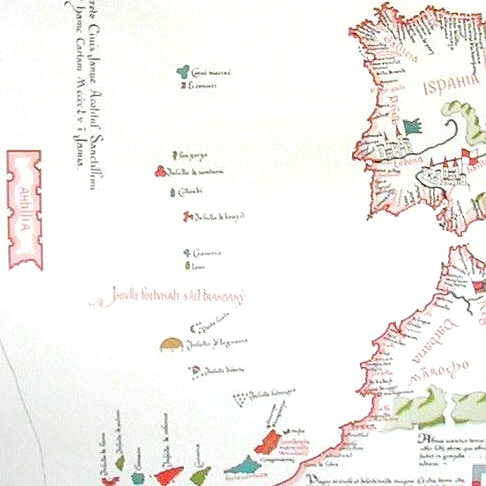
On February 7, 1539, Friar Marcos led a small scouting party from Culiacan, with Estévan as his guide.3 About six months later, Marcos was in Compostela, the capital of New Galicia, writing the report of his expedition to Viceroy Mendoza. He wrote that he went as far as a town called Cibola. Unfortunately, the natives of Cibola killed Estévan over a misunderstanding of some kind,4 and Marcos was afraid to enter the town. Still, he described it as "larger than the city of Mexico," with stone buildings that were several stories high. He said that, according to the natives, Cibola was in a province of seven cities, it was the least of the seven, and there were other even greater provinces beyond it. Marcos wrote that the land was very fertile and promising, and between Cibola and Culiacan there was an abundance of turquoise and fine hides. The natives also told him there was gold in a district to the east of the trail that he took.
This was more or less the full extent of Marcos de Niza's written report to the viceroy, but something happened that turned it into the most exciting news in New Spain. Many historians believe that in private and "off the record" conversations, Friar Marcos oversold and exaggerated the wealth and grandeur of what he saw in the northern wilderness. Others blame Mendoza, Coronado, and others for getting carried away and reading more into Marcos's report than what he wrote. However it happened, rumors were soon flying that the next great kingdom of wealth had been discovered in the New World: first Mexico, then Peru, and now Cibola.
One reason Spaniards were so ready to believe in an undiscovered land of great wealth was the myth of Antilla. As the story went, in the year 714, during the Muslim conquest of Portugal, seven Catholic bishops and their followers sailed west across the Atlantic Ocean to a rectangular island known as Antilla. There, they founded the Isle of Seven Cities. When Portugal and Spain began exploring the Atlantic Ocean in the 1400s, the island of Antilla was usually represented on maps, along with other mythical islands. At first, the failure to find Antilla only added to its mystique, and the legend was enhanced, making Antilla into a land of great wealth. Christopher Columbus's discovery of islands in the New World in 1492 made Spaniards believe the discovery of Antilla was just around the corner, and so the group of islands he discovered were called "the Antillies." Further exploration of these islands failed to find the fabled Seven Cities, but now it appeared as though Marcos had found them on the mainland.
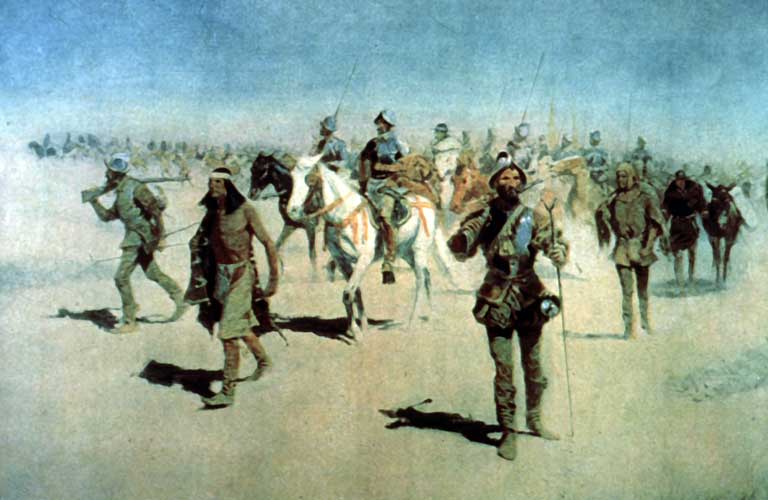
The Coronado Expedition, 1540-1542
Marcos went with Coronado to Mexico to report to Mendoza and plan the upcoming expedition in earnest. So as not to waste any time, Coronado ordered the alcalde of Culiacan, Melchior Díaz, to take a company ahead and do some more reconnaissance. Díaz set out on November 17, 1539.
Because of the general excitement in the country, Coronado had no problem finding men in New Spain who were ready to find their fortunes in Cibola. A force of 300 men and 800 natives assembled in Compostela. They departed on February 23, 1540. To show how important Viceroy Mendoza considered this expedition to be, he went to Compostela to see the army on its way, and even joined it for a couple days' march.
Before the army even reached Culiacan, a messenger came back with a letter from Melchior Díaz. It stated that Díaz had been unable to advance as far as Cibola because the winter weather had made the country too difficult to cross, but for as far as he went, he saw no gold or silver, heard no reports of it from any natives, and was not even sure the army would find enough to eat. Coronado tried to keep this sobering news to himself, but word spread among the men. Marcos performed damage control, assuring the men that everything would be as he described it, and they would soon be clutching gold in their hands.
The army reached Cibola in July. Instead of a city of gold, grander than Mexico, the Spaniards found what Pedro de Castañeda, a soldier in Coronado's army, called, "a little, unattractive village, looking as if it had been crumpled all up together."5 The men vented their anger and disappointment on Marcos: "such was the curses that some hurled at Friar Marcos," Castañeda writes, "that I pray God may protect him from them." Coronado's men conquered the town, which was on the New Mexico side of the Arizona-New Mexico state line at about the latitude of Albuquerque. After this, Coronado sent captains to investigate other leads. His men discovered the Grand Canyon, explored the north end of the Gulf of California, and explored the Rio Grande in New Mexico from about present-day Sonora to Taos. North of Albuquerque, near Bernalillo, they found a large village, or cluster of villages, called Tiguex. Coronado set up a headquarters at Tiguex and kept a large part of his army there for over a year.
While at Tiguex, the Spaniards met a native who they called "The Turk," Castañeda writes, "because he looked like one."6 The Turk told Coronado about a province to the north called Quivira and said there was gold and silver there. With The Turk as a guide, Coronado took a detachment of his army to find Quivira. This journey took him across the Panhandle and High Plains region of Texas. Little is known of his exact route. Most interpretations show him going east past Amarillo, then turning north and exiting the state in the extreme northeast corner in Lipscomb County. In 1996, however, copper crossbow points and other artifacts were discovered in Blanco Canyon in Floyd County. Many archeologists take these discoveries as conclusive proof of Coronado's presence there. This has shifted historians' interpretations of Coronado's route further south, closer to Lubbock, than previously believed.
Coronado arrived at Quivira, which is believed to have been near present-day Salina, Kansas, in June 1541. This may have been the village of metalworkers that Cabeza de Vaca and his colleagues wrote about. Coronado wrote to King Charles that a chief gave him a piece of copper that he wore around his neck. "I have not seen any other metal in these parts except this and some little copper bells which I sent him [the viceroy], and a bit of metal which looks like gold."7 In his letter to the king, Coronado wrote that his native guide lured him to Quivira hoping that the Spaniards would die from thirst on the journey. He also wrote that nothing Friar Marcos reported turned out to be true. The best place he saw for a settlement was Tiguex, but it would not work because it was too far from the oceans and was too cold in the winter. Coronado went back to Tiguex and then started back to New Galicia in April 1542. Disgraced and no longer friends with Viceroy Mendoza, he was removed from office in 1544.
Coronado's expedition gives us the first descriptions of the High Plains region and the bison-hunting natives that are usually taken to be Apaches. It also made another, lesser known contribution to Texas history. When Coronado left Tiguex, one of the Franciscans, Friar Juan de Padilla, wanted to stay to become a missionary to the natives at Quivira. A Portuguese lay brother named Andrés do Campo stayed with him. When Padilla, Campo, and their two native guides came to a large settlement in the Quivira province, the natives came out to do battle. Friar Padilla told Campo and the natives to flee on their one horse. From a nearby hill, Campo saw Padilla drop to his knees to await the natives' wrath, and watched as they killed him. He then traveled south through Oklahoma, Texas, and Mexico, arriving in Panuco. All that is known of his route through Texas is that he passed through "prickly pear country." His journey may have taken up to five years, and he might have lived as a slave for part of it. He was known to be in Mexico City in March 1547. While Campo left no written records of his trek across Texas, the fact that he made an overland journey from Quivira to Panuco was nevertheless an important step forward in Spain's knowledge of North American geography, for it showed that there was a shorter route to Quivira than the one taken by Coronado, and it also served to geographically connect the travels of Coronado with those of Cabeza de Vaca and Hernando de Soto.
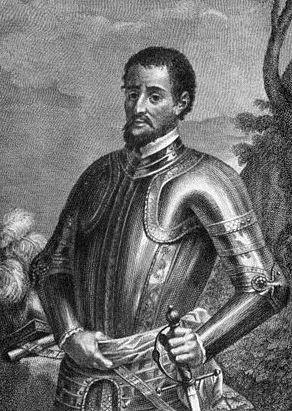
The De Soto Expedition, 1541-1542
Hernando de Soto, like most of the other conquistadors profiled in this three-part article, was born in Spain and came of age during the first wave of discovery and conquest launched by Christopher Columbus. He went to Central America as a young man and participated in the conquest of Nicaragua. He met Francisco Pizarro, joined his expedition to Peru, and became one of his captains. Failing to get the recognition and political authority afterward that he felt he deserved, he returned to Spain. He was fascinated by the news of Cabeza de Vaca and his colleagues' return to Spanish civilization and the reports they gave of their explorations in North America. His petition for the right to explore and colonize "Florida" - which was still Spain's name for all of the land on Gulf coast north of the Soto la Marina River in Tamaulipas - was granted in April 1537.
De Soto was also named governor of Cuba in 1538. He used Cuba mainly as a staging area for his Florida expedition. On May 10, 1539, he wrote a will and then embarked from Havana with 620 Spanish and Portuguese colonists, 237 horses, 200 pigs, and tons of heavy equipment on seven ships. De Soto's expedition was Spain's fourth attempt to settle Florida and was the largest, most ambitious effort it made to place a colony in the present-day United States.
Despite the fact that four different chronicles of the De Soto Expedition were preserved, there is greater uncertainty over its route than there is of the other North American expeditions, so it is only summarized briefly here. The expedition landed somewhere south of Tampa Bay. Like Narváez before him, De Soto marched his army northward. His men even found a Spaniard who had been left behind by one of the parties who had searched for Narváez eleven years earlier. That man, Juan Ortiz, was fluent in several native languages by then and served as an interpreter for De Soto. De Soto then went to the Tallahassee area. One of his captains found physical remnants of one of Narváez's camps, a place Cabeza de Vaca called the "Bay of Horses," at present-day Apalachee Bay.
De Soto then wandered around the southeastern United States, traveling through central Georgia, South Carolina, North Carolina, back through Georgia, Alabama, and Mississippi, On May 8, 1541, he discovered the Mississippi River, probably in the aptly-named De Soto County, Mississippi. He traveled back and forth across all of Arkansas and returned to the Mississippi River, where he died. To make his travels easier, De Soto had encouraged the natives to believe that he was a god, so his men concealed his death from them by burying his body in the river at night.
After De Soto's death, Luis de Moscoso took over the expedition. Moscoso wanted to end the expedition and try to get as many people to New Spain as possible. He went back across Arkansas and entered Texas in the vicinity of Texarkana in Bowie County. He traveled southwest for an undetermined distance, definitely crossing the Sabine and Neches Rivers, probably the Trinity, and possibly the Brazos. Moscoso then turned the expedition around and retraced his steps back to the site of De Soto's death on the Mississippi. His men built boats and floated down the river to its mouth on the Gulf of Mexico. They then made their way west along the coasts of Louisiana, Texas, and Mexico to Panuco. About 300 men survived the expedition.
Diminishing Interest in North America, 1542-1550
As this article shows, Spain's attempts to colonize the North American mainland in the 16th century consisted essentially of one huge success - that of Hernán Cortés - followed by one failure after another, including Ponce de León, Garay, Allyón, Narváez, Coronado, and De Soto. The main reason these other men were considered failures in their time, however, was not because of the loss of life and property their expeditions incurred, their failure to establish settlements, or their failure to convert natives to Christianity. They were considered failures because they did not find gold. There is no doubt that Cortés was an exceptionally talented man; some would even go so far as to say that as a leader and general, he has few peers in world history. He also had the good fortune, though, of being in the right place - a place of immense natural wealth. By 1542, it seemed clear to King Charles and everyone else that the rumors of gold and other riches in Florida, Quivira, Cibola, and all of the other unsettled areas of North America were too good to be true.
Not everyone wanted to abandon the dream. Pedro de Castañeda, who chronicled the Coronado Expedition, wrote that Coronado's decision to withdraw from Tiguex and the other native towns he conquered was unpopular with many of his officers and men. Castañeda further wrote that at the time he published his account, which was in the 1560s, "all or most of those who went on the expedition"8 lamented the fact that the country was not held onto and wished there was a way to get it back. The chroniclers of De Soto's expedition reported similarly concerning Moscoso's decision to end the expedition after De Soto's death. But the hard truth was - at least, at that time in history - if the crown did not see a way that a territory could generate fast wealth, that territory was not a priority, and if a would-be conquistador did not anticipate that he would be rewarded with great riches, he had no reason to invest his personal fortune and put his life at risk.
In keeping with his mandate and authority from King Charles, Cortés explored the Pacific Coast for a few years after his return to New Spain. In 1536, he discovered the Baja California Peninsula. The body of water separating it from the mainland, known today as the Gulf of California, was originally called the Sea of Cortés, in his honor. Instead of treating Cortés as an asset to be maximized, however, Viceroy Mendoza treated him like a rival to be suppressed. Frustrated, Cortés left New Spain for good in 1540. He made some requests to the Council of the Indies, but got nothing in return except for some smiles and polite words. Restless, he volunteered for a mission to Algiers in 1541. He became exasperated when the Spanish generals decided to lift their siege upon a Muslim stronghold and return home without calling upon him to give his analysis. When he recommended making an attack, yearning for captains and soldiers who possessed the courage of those who fought beside him in New Spain, they scoffed, telling him, "You would find the Moors quite a different foe from your naked savages."9
Cortés spent several more years making petitions to King Charles, begging for his services to be recognized and for his name to be cleared from the accusations made against him, but Charles declined to give him an audience. According to Voltaire, Cortés resorted to approaching the king's carriage on the street one day in 1544 and placed his foot on the step. "Who is this man?" the king demanded to know. "I am a man," Cortés replied, "who has given you more provinces than your ancestors left you cities." Even still, Charles did not entertain Cortés's requests. Voltaire's story, apocryphal though it may be, bears repeating because it illustrates not just the fickleness of men, but how Spain's view of North America had diminished in the 15 years since Cortés last saw the king. Pizarro's conquest of Peru, which was completed in 1533, made Cortés and New Spain yesterday's news. Downcast and exhausted, Cortés decided to go back to New Spain, but before he could leave, his health took a dive. He died on December 2, 1547 at age 62.
If the lack of conquistadorial grants after De Soto and King Charles's shabby treatment of North America's greatest hero were not enough to signal how Spain's attention had shifted away from the continent, the next sign came before the end of the decade. In 1544, Charles created the Viceroyalty of Peru, the South American counterpart to the office that Antonio de Mendoza held in New Spain. In 1549, the position became vacant. Charles offered it to Mendoza, but he would have to give up being Viceroy of New Spain. Mendoza accepted the offer.
Conclusion
In the 50 years after Columbus, Spain explored and mapped most of the coastlines of North and South America, discovered two great sources of gold, established several prosperous provinces, and killed, enslaved, or converted thousands upon thousands of natives. It sent three expeditions that explored the interior of the present-day United States. These expeditions visited at least 13 states; Texas is the only one visited by all three. Simply put, Spain did not find what it was looking for, and turned its attention elsewhere. Texas and the rest of the U.S. would receive very little of Spain's attention for the next few decades. Even so, these explorations had profound effects on the history of the United States and Texas. They gave Spain a legitimate claim to the southern half of the United States, decades before France and England would arrive. Spain would revive its interest in this region in 1700s and undertake several new colonization efforts, with varying degrees of success. Spain's claims to Texas and the southwestern U.S., which were inherited by Mexico, would result in two wars in the 1800s.
Although Spain's interest in the tierra nueva north of New Spain diminished after the 1540s, it did not die out completely. Daring and adventerous Spaniards continued to expand Spain's colonial frontier in the second half of the 16th century. Their efforts, and the effects they had on the future state of Texas, will be explained in an upcoming article.
By David Carson
Page last updated: March 25, 2021
1Mendoza stated in a letter to King Charles that he bought Dorantes's slave, who was a "person of reason," to serve as a guide. We do not know whether this means he became Mendoza's slave or whether the viceroy bought Estévan's freedom.
2He is referred to as "Coronado" in modern literature, but in his day, his surname was "Vázquez."
3In a report Marcos filed in Mexico on September 2, he states that he left Culiacan on March 7, but in a letter Coronado wrote from Culiacan on March 8, he states that Marcos left on "the seventh of last month." Surely, if Marcos had left on March 7, Coronado would have written "yesterday."
4Marcos was told that Estévan always sent a gourd decorated with bells and feathers before him to herald his arrival, and when the chief of Cibola saw the gourd, he flung it to the ground and forbade Estévan from entering the city. Estévan ignored the warning and was killed. George Parker Winship theorizes that the decorated gourd identified Estévan as an ally of Cibola's enemies. On the other hand, Coronado writes that the natives of Cibola told him they killed Estévan because he "assaulted their women." Castañeda offers several reasons and does allude to disrespect of women, but he also states that the leaders of Cibola thought he was an enemy spy.
5Castañeda, p. 483.
6Castañeda, p. 492.
7Coronado, p. 580.
8Castañeda, p. 472.
9Bancroft, p. 476
- Cabeza de Vaca, Álvar Núñez - La Relación. Translated to English by David Carson, 2016
- Castañeda, Pedro de - "The Narrative of Castaneda," translated by George Parker Winship, The Coronado Expedition 1540-1542, Washington, D.C., 1896
- Coronado, Francisco Vazquez - Letter to King Charles written October 20, 1541, translated by George Parker Winship, The Coronado Expedition 1540-1542, Washington, D.C., 1896
- Bancroft, Hubert Howe - History of Mexico Vol. 1, and Vol. 2,, published in The Works of Hubert Howe Bancroft, A. L. Bancroft & Company, 1883
